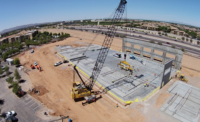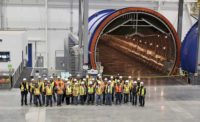While Canadian-born and built, Stantec provides engineering and architectural services through several key offices in the Southwest. The firm’s Arizona and Nevada operations have led the way in many respects, according to the firm’s leaders. For its work accomplished, community involvement and strong people skills in the region, ENR Southwest selects Stantec as this year’s Design Firm of the Year.
The Phoenix office became Stantec’s first U.S. presence in the late 1980s, followed by the addition of its Reno office a short time later. Phoenix was also the site for the firm’s first acquisition in 1991.
In this year’s ENR Southwest Top Design Firms, Stantec ranks No. 3, with $37.17 million of design revenue performed within Arizona, Nevada and New Mexico. Notable projects include the light rail starter line and extensions in Phoenix and the Boulder, Nev., Interstate 11 bypass outside of Las Vegas.
But Stantec also sits at No. 17 among the largest design firms in the world, according to ENR’s 2015 Global Design Firms ranking, with revenues of $2.2 billion. The international firm has made more than 75 acquisitions since 2000, helping it rise from No. 54 on the global survey in 2003 to its current ranking.
Acquiring Talent
“Stantec is a growth company,” says Curt Chapman, the firm’s vice president and regional lead for the Southwest.
A vast majority of the regional office leaders have been with the firm for decades and many of the acquisitions are made with the twin goals of adding to its geographic footprint and finding great people with deep connections, Chapman says.
“Our greatest assets walk out the door at the end of the work day,” he adds.
It’s the one-on-one relationships that matter, according to Paul Miller, operations manager with Truckee Meadows Water Authority, specifically citing Mike Wilkin, principal, Reno office. Miller estimates he has worked on dozens of projects with Wilkin and Stantec over the past few decades.
“It’s specifically all about Mike for me. He has a great background and he knows about the facilities. I will continue to work with him on projects moving forward. It’s always about relationships,” Miller says.
The geographic nature of Stantec’s acquisition strategy partly motivated the firm’s recent acquisition of MWH Global. Chapman says MWH’s Albuquerque office will help Stantec make new inroads into New Mexico.
The merger will also help the water conveyance practice, for which MWH Global is well respected, says Scot Schlund, Stantec’s managing senior principal in its water practice. “We view them as a leader in the water practice area. We think of them in a way that will add synergy,” he adds.
Stantec’s regional offices—located in Elko, Nev.; Las Vegas; two in Phoenix; Reno; two in Tempe, Ariz.; and Tucson—specialize in different market sectors, Chapman says. The company leverages that strength to perform jobs throughout the world by using staffers from a variety of offices, not exclusively in geographic areas.
Tucson-based John Take, vice president and sector leader, water conveyance, says the Tucson office is specifically engaged in out-of-region and international projects, specifically in the water sector. He says the work done by Stantec on the design-build Permanent Canal Closures and Pumps project in the city of New Orleans—one of the largest drainage pumping systems in the world—is one example. The Tucson office led the project hydraulics with assistance from staffers from other offices, including Phoenix. Take also served as technical advisor for the Ras Al Khair Seawater Conveyance System in Saudi Arabia, which uses seven pumps moving 460,000 gallons per minute of seawater through 28 miles of fiber-reinforced plastic pipe with diameters up to 132 in.
The Tucson office has a staff of about 35. Along with water services, the division provides residential and commercial development consulting.
Phoenix serves as a hub for the company, with four offices in the metropolitan area that host Stantec’s U.S. human resources and payroll functions and include more than 260 employees. The offices work in tandem and specialize in transportation, aviation, water, wastewater and environmental, among other sectors.
As the “center of excellence” for transportation projects, the Phoenix office primarily performs work in the region, says Bill Ferris, senior principal, transportation. Work is underway on a Mexico/New Mexico border master plan for the New Mexico Dept. of Transportation, which partly builds on recent similar work for the Arizona Dept. of Transportation. The firm also was the engineering firm of record on the Mariposa Port of Entry in Arizona for the Dept. of Homeland Security.
Schlund touts the water conveyance work the Phoenix office executes, citing the Horseshoe Dam river outlet works as one example. The project includes the construction of a new control valve building to be constructed at the outlet of the discharge tunnel without diverting the river.
The Salt River Project-owned facility formerly ran solely on diesel generators for electricity. “Now they are going to be able to switch over to hydroelectricity,” Schlund says.
The Reno office operates and offers similar services to the Phoenix office, but employees about 60 professionals, Chapman says. Staff in Reno and Elko, Nev., also perform specific mining-related work in the region and globally much in the same fashion as the Tucson office does with water. The Las Vegas office maintains about 12 full time staffers.
Building Communities and Professionals
Stantec hosts an annual Stantec in the Community Day event. In 2015, more than 7,300 staff performed public service projects in communities around the globe. In the Southwest, 36 Phoenix team members helped sort 8,000 lb of beans at the United Food Bank. In Reno, 32 volunteers removed invasive species and debris from a local creek bed to enhance its capabilities as a flood-control channel. Teams in Tempe and Tucson took up similar projects to support both the LoPiano Bosque Habitat and the Food Bank of Southern Arizona.
Beyond public service activities, the firm has fostered employee-eligible research and development initiatives for more than two decades. Currently, the program operates in two cycles each year and awards up to $1 million for employees to innovate new approaches to their jobs and the industry.
Take sits on the jury for the contest and says they received more than 70 applications in the last cycle. In Yuma, a group of Stantec professionals has been conducting company-funded research into different water line installation methods, including horizontal directional drilling and open cut, in partnership with Arizona State University. The researchers expect to increase the industry’s knowledge of productivity, water quality impacts, environmental impacts and when to apply each method.
Chapman says the firm will always stay focused upon the notion that hiring and improving great employees is tantamount to success.
“There is an old idiom that we believe in: We can’t worry about investing in our employees and watching them leave. We’ll have a bigger problem if we don’t help them grow and they stay,” Chapman says.





Post a comment to this article
Report Abusive Comment